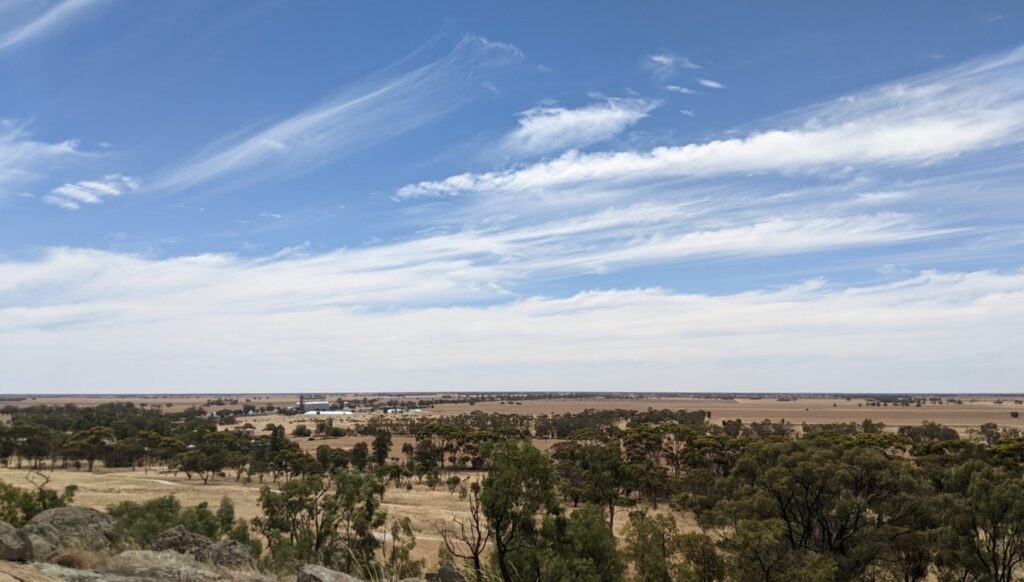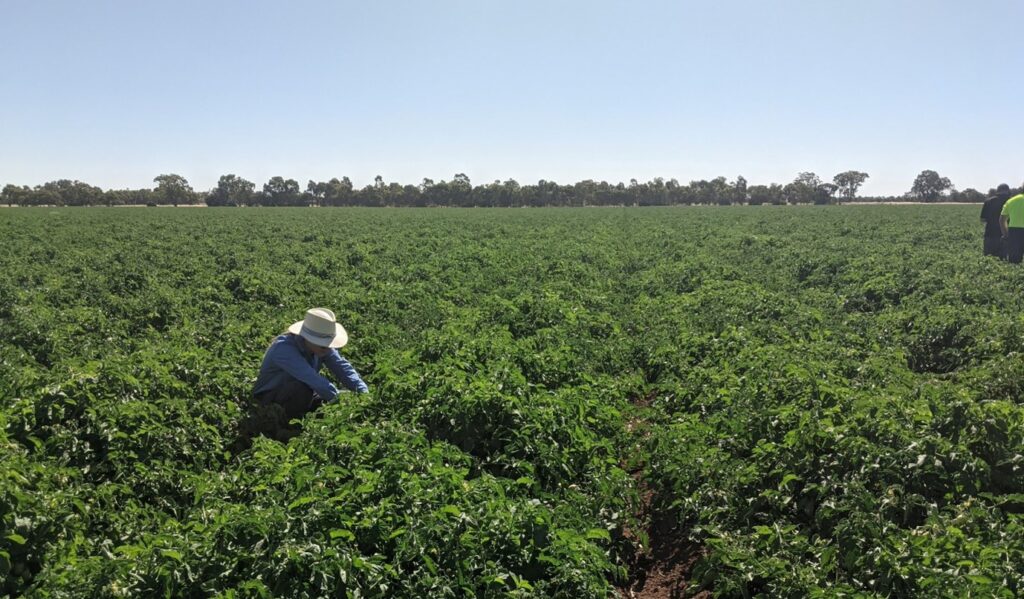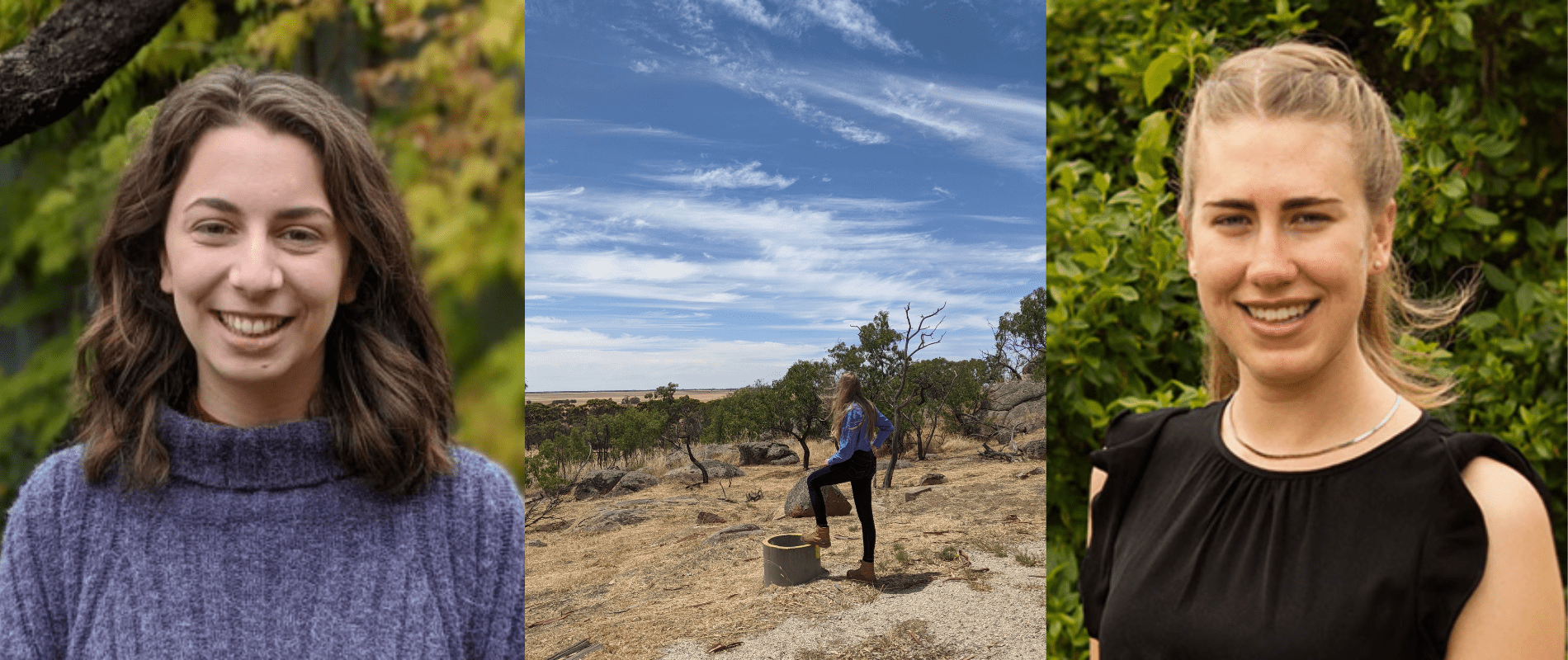Story by Rebecca Craine.
Rebecca (above left) is in her final year at ANU pursuing a Bachelor of Engineering and Earth Science. She is interested in sustainability and infrastructure and how these can be developed in the agricultural space. Rebecca is working at CEAT as a part of the Research Translation Initiative (RTI) team, focussing on technology uptake in piggery systems.
Earlier this month, Viv and I embarked on a journey through Northern Victoria to explore some of the region’s agricultural systems, in support of CEAT’s RTI work in applying ANU and CSIRO research to meet the current and future challenges of the agriculture industry. The goal for the week was to build connections with agricultural partners and gain an understanding of the challenges and advancements taking place within their agricultural systems. Visiting the region and seeing these systems in person allowed us to gain deeper insights into the unique challenges of these farms and their landscapes, and what kind of innovation could benefit these systems.

Day 1
Our first meeting of the trip was with Birchip Cropping Group (BCG), a farming systems group for the Wimmera and Mallee regions of Victoria, focussed on broadacre cropping. They showed us the research capability they use for farmer-led projects, with partners across the country, as well as their recently installed microgrid setup comprising of rooftop solar cells and battery energy storage. BCG has been able to use their system to supply energy for their own buildings and hope to be able to export electricity into the local grid in the future.
CEAT is currently developing projects investigating microgrids in agricultural settings, using solar photovoltaics and biogas derived from agricultural waste. It was interesting to discuss the challenges associated with micro-grids from their lived experiences, as well as looking at the potential to improve them. Like many rural areas, Birchip is at the edge of an electricity distribution network, so it is difficult to export the energy they produce, and policy surrounding these systems is not yet fully developed to support their implementation. Microgrids have the potential to improve grid stability and efficiency to support uptake of renewable energy generation, so there is hope that increased installation of such systems and further development of government policy will see more of these microgrid systems implemented successfully across the country.
We also discussed some of the research initiatives taking place at BCG. They have been involved in supporting the uptake of new agricultural technologies and practices for farmers in the region, and have facilitated collaborations between researchers, students, and farmers. They highlighted a key challenge they faced, which was not unfamiliar to us in our work at CEAT. Researchers may come up with interesting and innovative solutions for agriculture, but as the two parties had differing experiences and limited interaction, they may not be appropriate or applicable to the challenges faced by farmers. BCG described it as “building a bridge over the wrong river”. One strategy BCG is currently developing to help combat this, and to improve communication and understanding between researchers and farmers, is an accommodation and meeting space in Birchip. This will allow researchers to spend time in the area and perform research, whilst being able to easily visit local agricultural sites and meet with local agricultural experts. From even our short time spent on this trip, the understanding gained from meeting people and seeing agricultural systems operating in person, quickly outweighed what we had been able to gain from online research and email exchanges. The hope is that this facility will support interaction of researchers with industry, and yield innovative solutions to agricultural challenges that are tailored to the needs and limitations of farmers.
The morning meeting left us with the afternoon free to explore the surrounding areas. We paid a visit to the local landmark, Mt Wycheproof, which boasts the title of the world’s smallest registered mountain. Perhaps indicative of the local landscape, from atop the “mountain” – a full 43m above the surrounding landscape – we were able to get a better view of the area and take in its immense flatness, something that we had noted on our drive in. This flatness, as we learned, posed a unique challenge to the region – without any tall mountains to place cellular towers, a lot of the region is without internet connection. Although the use of sensors and precision agriculture systems is an emerging trend in many fields of agriculture, adoption is a challenge for many farmers due to lack of connectivity. Without reliable connectivity, local and global data transmission is difficult, and thus limits producer’s ability to access key decision support data and frameworks.

We were also told that this area was some of the most productive dryland cropping land in Australia, something that had not been apparent to us on the drive in, as harvest had recently taken place and so the landscape was a stark contrast from the La Nina-driven lushness of the Canberra and surrounding region. Although gaining data from sensors and monitoring can provide immense value in some agricultural systems, we learnt that in the case of local dryland cropping, there was little uptake or interest in soil moisture monitoring, as without irrigation, there was not much action that could be taken based on this information. The true challenge for these farmers is long term predictions of weather and rainfall. Without being able to predict a year’s rainfall, farmers rely on careful balancing of risk and an element of chance in their decision making. When dealing with the somewhat unpredictable nature of weather and drought, the agricultural industry is looking towards diversified income streams for farmers to improve resilience and provide alternatives in times of water shortage.
Day 2
Our second day of the trip saw us travelling to Kerang, Gunbower and Patho to visit the piggeries that CEAT has been collaborating with over the past few years. For Viv and I, who have both been working on projects related to piggeries at CEAT, this was our first time visiting a commercial piggery. We had the opportunity to look inside the systems we had been analysing and researching, and see them in operation – a highly valuable experience for our team to help ensure the work we develop is appropriate for the systems in place.
An interesting contrast we were able to see in visiting these piggeries was the diverse age, and therefore technology present, between them. One of the sites is a recent build and was therefore making use of some of the newest technologies in the field, as opposed to the other sites, where the original structures dated as far back as the 1960s and made use of more traditional, manual practices. At the new site, barn conditions are constantly maintained and monitored remotely, and in the case of any unexpected issues, the farmer is notified by warnings sent to their phone. Electronic sow feeding stations provide food to the sows automatically and track their daily intake to ensure they are eating healthily. These advanced systems allow the farmers to monitor their barns and gain deeper insights into their operation, identify any issues faster, and reduce the labour involved in the system.
Outside the barns, we were also given the chance to see the piggeries’ waste management systems. Traditionally, pig waste is stored in ponds to break down, which can release strong odours and harmful greenhouse gasses into the air. These piggeries were investigating alternative uses for the waste. A popular adaptation, which we were able to see in practice, is where effluent from piggeries is stored in a covered lagoon. The methane released in digestion of the effluent is combusted to reduce their greenhouse emission potential, or used to generate electricity and heat, yielding more than enough energy to power the entire site. Solids removed from the effluent and processed liquid waste is a very rich fertiliser and can be sold on to nearby growers to fertilise their crops.
One challenge arising around these improved waste systems is their cost, and while small and medium piggeries usually produce more biogas than they can use in energy consumption, the return on investment may not exist due to economies of scale, and low wholesale electricity prices when feeding back into the grid. Whilst visiting the piggeries we discussed alternative opportunities, such as collaborating with nearby producers of other waste streams to generate enough biogas to support a microgrid and sell energy at better rates, or to use the excess energy to power additional activities such as a feed mill or other animal production systems. Such activities can enable farmers to not only reduce their environmental impact, but can also provide diversified income streams to improve their profitability and resilience.
Day 3
Our third and final visit of the trip was to an Australian Processing Tomato Research Council (APTRC) crop inspection in the region surrounding Echuca. At this event we visited three tomato growing enterprises, where different field trials were being conducted surrounding plant breeds and crop spacing. We were able to meet tomato growers, technology providers and agricultural scientists, all involved in the tomato growing system.
CEAT is currently involved in a project investigating the gasification of tomato vine waste to create synthesis gas for green hydrogen, fuel or ammonia production. An important factor in understanding the feasibility of this project is understanding how the tomatoes are harvested and how the vines are treated in the process. On most of the farms, real concerns over disease carryover prevent the vines from being incorporated back into the soil as is done in some other cropping systems, so the vines are traditionally raked and then burnt in the field after the fruit is harvested.
As in many systems, transport is a key challenge in establishing a system to make use of these vines. Depending on the yield from the gasification process, the cost and labour in collecting and transporting the vines from the field to a processing site could be prohibitive. This can be a significant challenge for many small and medium agricultural sites where the cost of installing and operating systems, or transporting materials to make use of their waste, may outweigh the benefit of implementing such a system. One method discussed to make the transport of these materials easier is a process called pelletisation; by which the plant matter is compressed into pellets, increasing the density of the material and making it easier to transport. However, the cost of such a system can also be prohibitively high, and whilst used commercially for cereal straws, may face technical difficulties due to the composition of tomato vines.
Where it may not be feasible for a single site to own and operate a gasification or pelletisation facility, CEAT has been exploring opportunities for producers of similar waste streams existing in close proximity to each other to create partnerships and make use of the economy of scale to improve the feasibility of processes. Where the introduction of advanced technologies can often be expensive, collaboration between producers can help share the cost burden, while increasing throughput to improve efficiency and profitability. Although the local tomato waste is our current focus, our visit allowed us to observe and discuss other agricultural waste streams and regions of tomato growing where there may be potential to make use of these products in energy generation.

Whilst exploring these tomato farms, we also discussed the implementation of precision agriculture using soil sensors and other remote monitoring systems to improve farm management. Processing tomato crops are irrigated using sub surface drip irrigation (drip tapes placed underground), allowing water and fertilisers to be pumped to them, whilst limiting water loss. As opposed to the dryland farming we saw earlier, this seemed to hold potential opportunity for improved intervention and decision making based on collected data. The challenge of implementing such a system, we learnt, was that large fields such as these were currently only serviced by a small number of irrigation valves, where the soil and plant conditions could vary considerably within the domain of drip tapes controlled by a single valve. This would mean that a more detailed understanding of the soil conditions could not be precisely acted upon, and with irrigation lines buried below the ground, making changes to the system would be a difficult process. We learnt that these drip tapes do however need to be dug up and replaced every 5-10 years, which leaves potential for more complex systems to be installed as their replacement without introducing much additional work to the process.
Another difficulty faced in implementing precision agricultural systems is around system interoperability. A range of systems are needed to control the whole farm, but systems from different providers do not interact with each other, meaning reinvestment to one provider is needed. However, sometimes the range of systems required at a farm level are not available from a single provider, meaning significant manual labour is needed for farm level management of these systems, whilst service fees are multiplied across several providers.
Introduction of new systems can often be limited by resistance to change and the high cost of new technologies, however we did learn that significant industry change was not unfamiliar in these tomato growing systems. Where irrigation had previously been performed by flood irrigation systems, government financial support to improve water efficiency in the region had led to many farmers opting into these underground drip tape systems.
Having researchers and advocates, such as those at the APTRC event, investigating improved growing systems to share with farmers, can help to show the industry the potential benefits of changes to their systems and encourage farmers to invest in technologies that may improve their yield or efficiency.
The learning and experience gained on this trip was highly valuable and allowed us to bring broader insight into the projects currently being undertaken at CEAT, as well as to identify opportunities for future work. It was heartening to see so many developments underway towards a more sustainable future in agriculture. Whether it be cleaner energy, reduction of waste, or precision agriculture, there are many opportunities to further innovation and sustainability in the agricultural space.
